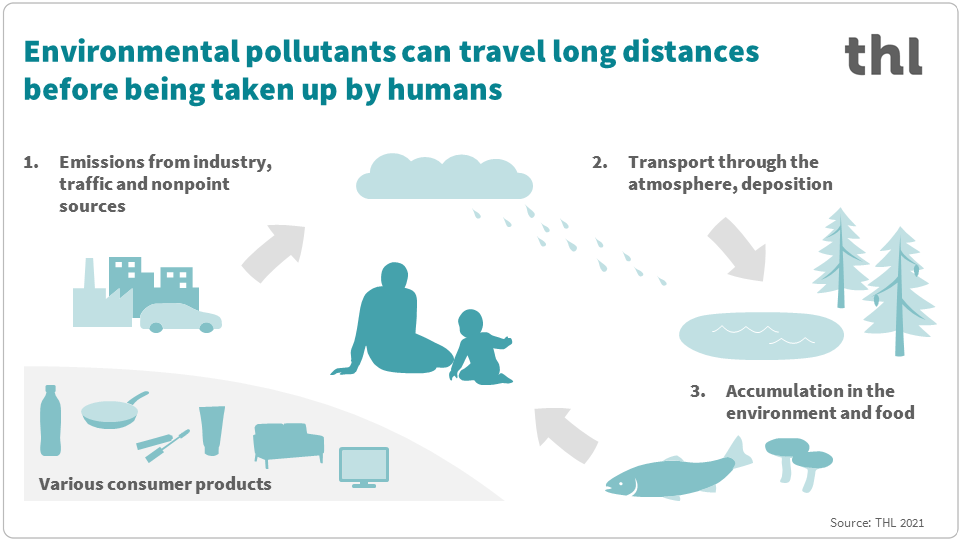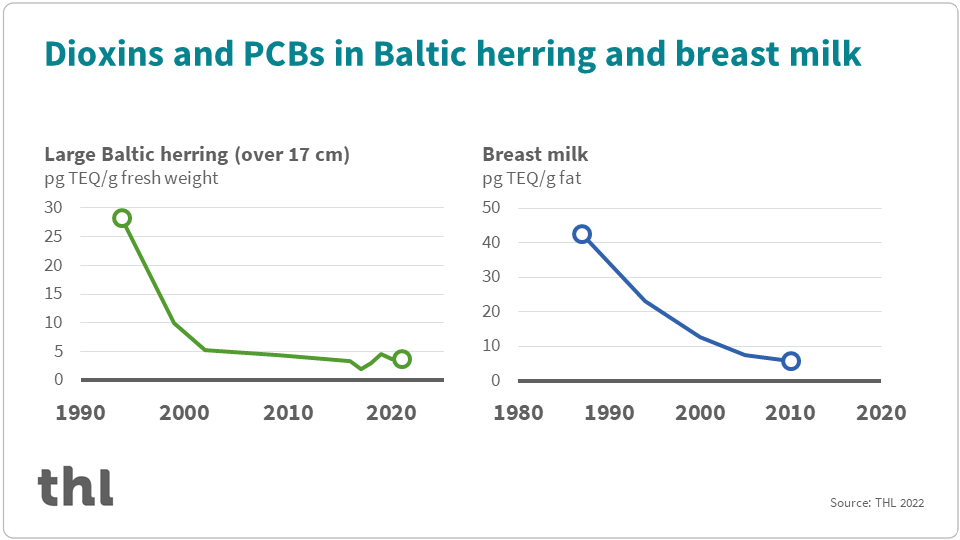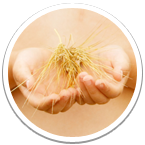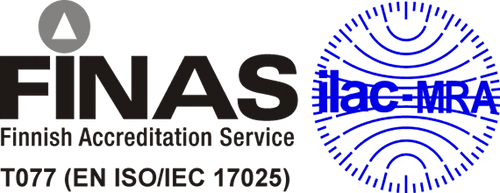Environmental pollutants
Environmental pollutants are chemicals that have ended up in the environment as a result of human activities and that are hazardous to health.
In Finland, people are exposed to environmental pollutants mainly through food, but also through inhalation and sometimes through skin.
Page content:
- Preventing the harmful health effects of environmental pollutants
- Environmental pollutant levels in Finland are low
- Health benefits of fish consumption outweigh the potential harmful effects of pollutants
- The best way to reduce exposure is to follow the fish consumption guidelines

Preventing the harmful health effects of environmental pollutants
THL studies how much and by which routes the population in Finland is exposed to environmental pollutants and assesses the health risks associated with the exposure.
Our research focuses on compounds that are harmful or toxic for humans and that are either persistent and bio-accumulative in the environment or that humans are continually exposed to. These types of pollutants pose the highest risk to health and include dioxins and PCBs, brominated flame retardants, chlorinated pesticides, fluorinated compounds, bisphenol A, parabens, phthalates and organic tin compounds.
New chemicals are constantly being developed and placed on the market, and our goal is to identify and reduce their potential health risks as well.
At THL’s Laboratory of Chemistry, we analyze the levels of environmental pollutants in humans, as well as in food, animal feed and environmental samples. Our analytical services are available for collaborative research projects and, depending on the analysis, also for external clients.
Read more: Environmental pollutant analysis
Environmental pollutant levels in Finland are low
Concentrations of many environmental pollutants in the Finnish environment have decreased in recent decades on account of legislative measures.
The decrease in the concentrations of environmental pollutants has also resulted in reduced human exposure. THL has monitored the concentrations of dioxins and PCBs in Finnish diet and breast milk since the 1980s, during which time the concentrations have decreased dramatically. However, environmental pollutants will continue to cause concern, since not all pollutants have decreased similarly, and in some cases monitoring data is not available at all.

Health benefits of fish consumption outweigh the potential harmful effects of pollutants
Fish is the main source of many environmental pollutants in Finland.
This is because many pollutants – regardless of source or chemical properties – have a tendency to end up in water systems and accumulate in fish. Compliance with the Finnish dietary advice on fish consumption is thus the best way to avoid exposure, while also ensuring the intake of necessary nutrients, such as omega-3 fatty acids and vitamin D. The amount of fish in the diet should not be decreased, even if they may contain small amounts of pollutants. According to research data, the health benefits of fish outweigh the possible harmful effects of environmental pollutants. Instead, different types of fish should be eaten variedly, so that exposure to any one substance will not increase too much.
Read more:
- Fish is good for health (in Finnish)
- Vitamin D (Fineli)
- Questions and answers about fat quality (in Finnish)
The best way to reduce exposure is to follow the fish consumption guidelines
According to the recommendations of the National Nutrition Council and the Finnish Food Authority:
- fish should be eaten at least twice a week
- different fish species should be varied in the diet.
Because of environmental pollutants, some exceptions have been issued:
- Children, young people and people of fertile age may not eat large herring, which uncleaned are longer than 17 cm, or alternatively salmon or trout caught in the Baltic Sea more often than once or twice a month.
- Children, young people and people of fertile age may not eat pike caught in a lake or in the sea more often than once or twice a month.
- Pregnant women and nursing mothers should not eat pike at all due to the mercury accumulated in pike.
- People who eat fish from inland waters on a daily basis are advised to reduce their consumption of also other predatory fish that accumulate mercury. Apart from pike, these include large perches, pike perches and burbots
Read more: Safe use of fish (Finnish Food Authority)
The unit is a FINAS accredited testing laboratory T077. It has been accredited according to the standard SFS-EN ISO/IEC 17025:2005 and its scope of accreditation is available on the website of FINAS (Finnish Accreditation Service).





